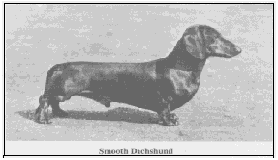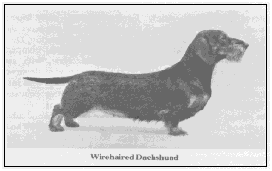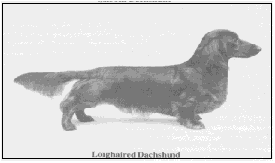

AKC STANDARD FOR THE DACHSHUND
![]()
General Appearance - Low to ground,
long in body and short of leg with robust muscular development, the skin is
elastic and pliable without excessive wrinkling. Appearing neither crippled,
awkward, nor cramped in his capacity for movement, the Dachshund is
well-balanced with bold and confident head carriage and intelligent, alert
facial expression. His hunting spirit, good nose, loud tongue and distinctive
build make him well-suited for below-ground work and for beating the bush. His
keen nose gives him an advantage over most other breeds for trailing. NOTE:
Inasmuch as the Dachshund is a hunting dog, scars from honorable wounds shall
not be considered a fault. Size, Proportion, Substance - Bred and shown in two
sizes, standard and miniature, miniatures are not a separate classification but
compete in a class division for "11 pounds and under at 12 months of age and
older." Weight of the standard size is usually between 16 and 32 pounds.
Head - Viewed from above or from the side, the head tapers uniformly to the tip
of the nose. The eyes are of medium size, almond-shaped and dark-rimmed, with an
energetic, pleasant expression; not piercing; very dark in color. The bridge
bones over the eyes are strongly prominent. Wall eyes, except in the case of
dappled dogs, are a serious fault. The ears are set near the top of the head,
not too far forward, of moderate length, rounded, not narrow, pointed, or
folded. Their carriage, when animated, is with the forward edge just touching
the cheek so that the ears frame the face. The skull is slightly arched, neither
too broad nor too narrow, and slopes gradually with little perceptible stop into
the finely-formed, slightly arched muzzle. Black is the preferred color of the
nose. Lips are tightly stretched, well covering the lower jaw. Nostrils well
open. Jaws opening wide and hinged well back of the eyes, with strongly
developed bones and teeth.
Teeth - Powerful canine teeth; teeth fit closely together in a scissors bite. An
even bite is a minor fault. Any other deviation is a serious fault. Neck - Long,
muscular, clean-cut, without dewlap, slightly arched in the nape, flowing
gracefully into the shoulders.
Trunk - The trunk is long fully muscled. When viewed in profile, the back lies
in the straightest possible line between the withers and the short very slightly
arched loin. A body that hangs loosely between the shoulders is a serious fault.
Abdomen - Slightly drawn up.
Forequarters - For effective underground work, the front must be strong, deep,
long and cleanly muscled.
Forequarters in detail: Chest - The breast-bone is strongly prominent in front
so that on either side a depression or dimple appears. When viewed from the
front, the thorax appears oval and extends downward to the mid-point of the
forearm. The enclosing structure of the well-sprung ribs appears full and oval
to allow, by its ample capacity, complete development of heart and lungs. The
keel merges gradually into the line of the abdomen and extends well beyond the
front legs. Viewed in profile, the lowest point of the breast line is covered by
the front leg.
Shoulder Blades - Long, broad, well-laid back and firmly placed upon the fully
developed thorax, closely fitted at the withers, furnished with hard yet pliable
muscles.
Upper Arm - Ideally the same length as the shoulder blade and at right angles to
the latter, strong of bone and hard of muscle, lying close to the ribs, with
elbows close to the body, yet capable of free movement.
Forearm - Short; supplied with hard yet pliable muscles on the front and
outside, with tightly stretched tendons on the inside at the back, slightly
curved inwards. The joints between the forearms and the feet (wrists) are closer
together than the shoulder joints, so that the front does not appear absolutely
straight. Knuckling over is a disqualifying fault.
Feet - Front paws are full, tight, compact, with well-arched toes and tough,
thick pads. They may be equally inclined a trifle outward. There are five toes,
four in use, close together with a pronounced arch and strong, short nails.
Front dewclaws may be removed.
Hindquarters - Strong and cleaned muscled. The pelvis, the thigh, the second
thigh, and the metatarsus are ideally the same length and form a series of right
angles. From the rear, the thighs are strong and powerful. The legs turn neither
in nor out.
Metatarsus - Short and strong, perpendicular to the second thigh bone. When
viewed from behind, they are upright and parallel.
Feet - Hind Paws - Smaller than the front paws with four compactly closed and
arched toes with though, thick pads. The entire foot points straight ahead and
is balanced equally on the ball and not merely on the toes. Rear dewclaws should
be removed.
Croup - Long, rounded and full, sinking slightly toward the tail. Tail - set in
continuation of the spine, extending without kinks, twists, or pronounced
curvature, and not carried too gaily.
Gait - Fluid and smooth. Forelegs reach well forward, without much lift, in
unison with the driving action of hind legs. The correct shoulder assembly and
well-fitted elbows allow the long, free stride in front. Viewed from the front,
the legs do not move in exact parallel planes, but incline slightly inward to
compensate for shortness of leg and width of chest. Hind legs drive on a line
with the forelegs, with hocks (metatarsus) turning neither in nor out. The
propulsion of the hind leg depends on the dog's ability to carry the hind leg to
complete extension. Viewed in profile, the forward reach of the hind leg equals
the rear extension. The thrust of correct movement is seen when the rear pads
are clearly exposed during rear extension. Feet must travel parallel to the line
of motion with no tendency to swing out, cross over, or interfere with each
other. Short, choppy movement, rolling or high-stepping gait, close or overly
wide coming or going are incorrect.
The Dachshund must have agility, freedom of movement, and endurance to do the
work for which he was developed.
Temperament - The Dachshund is clever, lively and courageous to the point of
rashness, persevering in above and below ground work, with all the senses
well-developed. Any display of shyness is a serious fault.
Special Characteristics of the Three Coat Varieties - The Dachshund is bred with
three varieties of coat: (1) Smooth; (2) Wirehaired; (3) Longhaired and is shown
in two sizes, standard and miniature. All three varieties and both sizes must
conform to the characteristics already specified. The following features are
applicable for each variety:
![]()

![]()
Smooth Dachshund -
Coat - Short, smooth and shining. Should be neither too long nor too thick. Ears not leathery.
Tail - Gradually tapered to a point, well but not too richly haired. Long sleek
bristles on the underside are considered a patch of strong-growing hair, not a
fault. A brush tail is a fault, as is also a partly or wholly hairless tail.
Color of Hair - Although base color is immaterial, certain patterns and basic
colors predominate. One-colored Dachshunds include red (with or without a
shading of interspersed dark hairs or sable) and cream. A small amount of white
on the chest is acceptable, but not desirable.
Nose and nails - black.
Two-colored Dachshunds include black, chocolate, wild boar, gray (blue) and fawn
(Isabella), each with tan markings over the eyes, on the sides of the jaw and
underlip, on the inner edge of the ear, front, breast, inside and behind the
front legs, on the paws and around the anus, and from there to about one-third
to one-half of the length of the tail on the underside. Undue prominence or
extreme lightness of tan markings is undesirable. A small amount of white on the
chest is acceptable but not desirable. Nose and nails - in the case of black
dogs, black; for chocolate and all other colors, dark brown, but self-colored is
acceptable. Dappled dachshunds - The "single" dapple pattern is expressed as
lighter-colored areas contrasting with the darker base color, which may be any
acceptable color. Neither the light nor the dark color should predominate. Nose
and nails are the same as for one and two-colored Dachshunds. Partial or wholly
blue (wall) eyes are as acceptable as dark eyes. A large area of white on the
chest of a dapple is permissible. A "double" dapple is one in which varying
amounts of white coloring occur over the body in addition to the dapple pattern.
Nose and nails: as for one and two-color Dachshunds; partial or wholly
self-colored is permissible. Brindle is a pattern (as opposed to a color) in
which black or dark stripes occur over the entire body although in some
specimens the pattern may be visible only in the tan points.
![]()

![]()
Wirehaired
Dachshunds -
Coat - With the exception of jaw, eyebrows, and ears, the whole body is covered
with a uniform tight, short, thick, rough, hard, outer coat but with finer,
somewhat softer, shorter hairs (undercoat) everywhere distributed between the
coarser hairs. The absence of an undercoat is a fault. The distinctive facial
furnishings include a beard and eyebrows. On the ears the hair is shorter than
on the body, almost smooth. The general arrangement of the hair is such that the
wirehaired Dachshund, when viewed from a distance, resembles the smooth. Any
sort of soft hair in the outercoat, wherever found on the body, especially on
the top of the head, is a fault. The same is true of long, curly, or wavy hair,
or hair that sticks out irregularly in all directions.
Tail - Robust, thickly haired, gradually tapering to a point. A flag tail is a
fault.
Color of Hair - While the most common colors are wild boar, black and tan, and
various shades of red, all colors are admissible. A small amount of white on the
chest, although acceptable, is not desirable.
Nose and nails - same as for the smooth variety.
![]()

![]()
Longhaired
Dachshund -
Coat - The sleek, glistening, often slightly wavy hair is longer under the neck
and on forechest, the underside of the body, the ears and behind the legs. The
coat gives the dog an elegant appearance. Short hair on the ear is not
desirable. Too profuse a coat which masks type, equally long hair over the whole
body, a curly coat, or a pronounced parting on the back are faults.
Tail - Carried gracefully in prolongation of the spine; the hair attains its
greatest length here and forms a veritable flag.
Color of Hair - Same as for the smooth Dachshund.
Nose and nails - same as for the smooth.
![]()
The foregoing description
is that of the ideal Dachshund. Any deviation from the above described dog must
be penalized to the extent of the deviation keeping in mind the importance of
the contribution of the various features toward the basic original purpose of
the breed.
DISQUALIFICATION Knuckling over of front legs.
![]()
Approved April 7, 1992 Effective May 27, 1992
Home